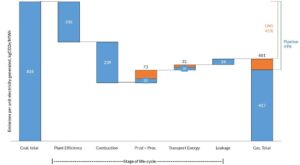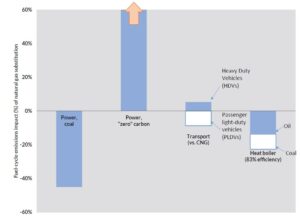A new analysis shows that replacing coal with gas in the power sector can bring significant benefits, but the climate-economy “win-win” seen recently in the U.S. may be hard to replicate – or even to sustain long-term.
The Lakeside Power Station in Vineyard, Utah. Flickr / arbyreed
![]()
The U.S. shale gas revolution has dramatically increased supplies of low-cost natural gas, upended U.S. coal markets, and led many electric utilities to switch from coal to natural gas, reducing air pollution and greenhouse gas emissions. While there remain concerns about some of the impacts of hydraulic fracturing (“fracking”), the trend toward increasing use of natural gas is widely expected to continue.
The U.S. experience has heightened interest in natural gas as a potential “bridge” to a low-carbon energy future. Energy demand continues to rise rapidly around the world; without new policies, the International Energy Agency (IEA) projects that more than 1,000 GW of new coal power capacity will be added in 2013–2035 alone. Expanding the natural gas supply, many argue, could help avoid “locking-in” coal power by providing a cleaner, more efficient alternative while renewable technologies are scaled up.
Yet an analysis for the New Climate Economy project shows the climate implications of increased natural gas use are far from straightforward. While it could, indeed, help avoid “lock-in” of new coal power plants, it could also “lock-out” other, lower-emission alternatives. Without carefully designed policy “guardrails”, the authors warn, using a natural gas as a “bridge” could be very risky.
“Natural gas is inherently attractive to policy-makers – it has air pollution benefits, it’s a conventional option, and if produced locally, it enhances energy security and creates jobs. So it’s very tempting to see it as a climate solution in the short to medium term,” says Michael Lazarus, senior scientist and U.S. Center director at the Stockholm Environment Institute and lead author of the paper.
“Oil and gas companies are also actively promoting the concept, especially in the run-up to the Paris Climate Change Conference this December,” he adds. “But before we build a natural gas ‘bridge’, we need to make sure it will take us where we want to go – to a truly carbon-free energy system.”

Potential GHG benefits of substituting natural gas for coal in the power sector.
Finding ‘win-win’ opportunities for the economy and the climate
The new paper is based on analysis conducted for the New Climate Economy, the flagship project of the Global Commission on the Economy and Climate, a major international initiative to analyse and communicate the economic benefits and costs of acting on climate change.
“Two thirds of global greenhouse gas emissions come from energy production and use,” says New Climate Economy Programme Director Helen Mountford. “That means transforming energy systems is crucial to keeping global warming below 2°C. The New Climate Economy work demonstrates that it is possible and economically beneficial to transition to a low-carbon energy system that also reduces the enormous health costs of energy-related air pollution and connects those without access to energy. There is growing interest in natural gas as a potential ‘bridge’ fuel to this goal. This paper provides robust analysis to help policy-makers understand the potential benefits but also the risks associated with this option, and provides suggestions on how to manage these.”
The paper starts by exploring the potential emission reductions associated with a switch from coal to gas, and finds that in the power sector, such a switch could reduce greenhouse gas (GHG) emissions by up to 50%. Gas is also used in many other sectors, however – from building heat, to industry, to transportation – and the GHG savings in those applications can be much lower.

Potential GHG impact of substituting natural gas across different sectors.
In all cases, the climate benefits hinge to a great extent on minimizing leakage of methane, the main component of natural gas and a powerful greenhouse gas. Leakage can occur during gas extraction, processing, transportation and storage, and distribution. While low-cost technologies and management practices exist for limiting leaks – to less than 1% – in practice leakage rates vary widely across production and delivery systems, and are highly uncertain.
Another, less widely discussed risk is that making gas cheaper and more abundant could lead to increased energy demand, offsetting any emission reduction benefits, Lazarus says. Moreover, there are substantial lock-in risks, because ramping up gas production and delivery to the regions where most new coal power is being built, East and South Asia, would require major investments in long-lived gas infrastructure, such as pipelines and liquefied natural gas (LNG) terminals.
“On the upside, gas power plants are less expensive to build than coal, and can run flexibly to help accommodate increasing amounts of intermittent renewables,” Lazarus says. “The risk lies particularly with new infrastructure, such as LNG facilities and pipelines, can require take-or-pay contracts, and create strong incentives to maintain and increase gas use, potentially over several decades.”
Thus, the paper concludes, if policy-makers want to use gas as a “bridge”, they need to add “guardrails” to limit energy demand growth; manage and reduce methane leakage; direct any added gas supplies to the application with the greatest climate benefit (replacing coal in the power sector); and restrict the extent of lower-carbon technology lock-out.
“Natural gas could play an important though limited bridging role, but only if adequate guardrails are in place,” says Lazarus. “We’ll need policies like strong carbon pricing, methane regulations, and renewable portfolio standards to make sure we maximize the benefits and minimize the risks.”
The paper, Natural Gas: Guardrails for a Potential Climate Bridge, was written by Michael Lazarus and Kevin Tempest, of the SEI U.S. Center; Per Klevnäs, of SEI’s Stockholm Centre and the New Climate Economy, and Jan-Ivar Korsbakken, of the New Climate Economy.
Design and development by Soapbox.
